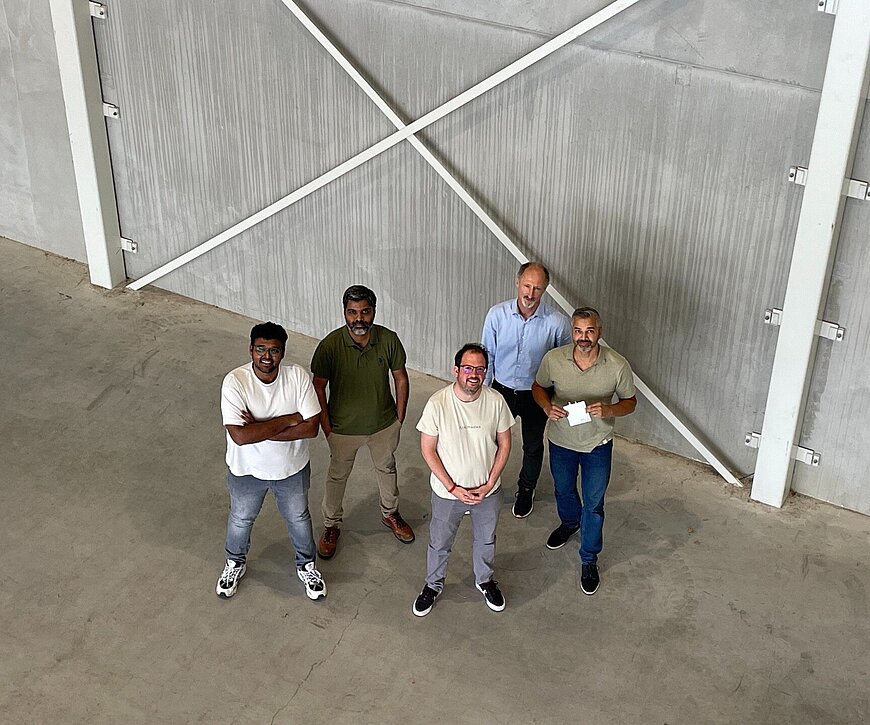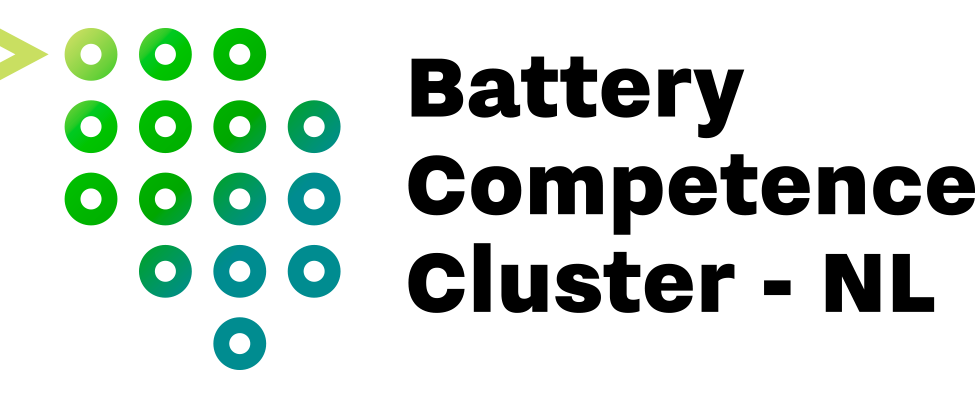Stop talking, start building: The future of safer batteries with Solid-State

Arkimedes is a solid-state battery company, born and incubated at the reactor institute of TU Delft, now building its new base at Cleantech Campus Arnhem to grow further. We sat down for a round table conversation with Satish Pultoo, Deepak Singh, Remco van der Jagt, Sander Groenteman and Vignesh Kannan at Arkimedes.
Solid state isn’t a vision for 2050, it’s happening now. At Arkimedes, safer batteries are designed and built in Europe today, with safety engineered into the chemistry from the very beginning. With Battery Day in Arnhem around the corner, we asked the team why now is the right moment to share their story and what visitors can expect.
What makes Battery Day the right moment to share your story?
Satish: Last year’s events were interesting, but mostly geared toward big companies talking about 2030 or 2050. We want to shift the focus to what’s actually happening now in the Netherlands. Real deep tech technologies around the world are being built today by startups and small SMEs.
What will visitors and partners take away?
Remco: You’ll leave with a clear picture of today's battery landscape and know what is truly happening in the Netherlands right now.
Satish: And you’ll see why a European supply chain matters: a local factory doesn’t just mean technology; it means we create jobs in the entire supply in the Netherlands and across Europe.
So, scaling up really means strengthening the manufacturing industry here in the Netherlands and across Europe?
Satish: Yes, as Arkimedes scales in the coming years, it will mean real manufacturing in Europe, and at least 1,000 jobs in the Netherlands.
Solid state: safer by design, built in Europe
Satish, could you describe the team in three words?
Satish: Remco: Critical mind, Innovative, Multitasking. Vignesh: Energetic, Tech, Resilient. They have been the ‘main engines’ of Arkimedes from day one. From science and scaling up technology to corporate discussions. Sander: Leader, Expert, Empowering. He is building Arkimedes’ new verticals ground up. And Deepak: Strategic, Visionary, Practical. Over a decade ago, he said LFP (Lithium Iron Phosphate) would become the dominant battery chemistry, even for automotive. Many laughed, but he stuck with it. And look it’s everywhere. That blend of vision and pragmatism is rare. And having all these individuals together under one roof is even rarer.
And how would you describe Satish?
Deepak: I think ‘Courage’ says enough. The more you know, the more you realize how hard the battery industry is. Satish still chose to start, to take on the complexity and put in the effort. That’s true entrepreneurial spirit.
What kind of company is Arkimedes?
Satish: Arkimedes is a deeptech battery company, built upon decades of fundamental research coming out from Prof. Marnix Wagemaker Lab at TU Delft. We’re goal-oriented and value-driven, not money-driven. Innovation here is built on flexibility and a sense of ownership. We are self-starters and continuously ask, "How can I contribute?" That attitude guides us from initial strategy all the way to rolling up our sleeves and getting the job done.
Deepak laughing: And for us, batteries aren’t just work. They’re almost a calling. We think about them constantly, simply because we love the technology. It’s not just a job, it’s our passion.
If we look at the technology, what is a solid-state battery, in simple terms?
Deepak: Think of it as a battery without liquids. In a typical lithium-ion battery, a flammable liquid moves ions between electrodes. We replace that with a solid ionic conductor. The result is inherently safer, often more compact, and lighter, because you can remove a lot of protective packaging. That also means a smaller bill of materials. First safer, then lighter.
Satish: It’s also more material-efficient, less plastic, fewer containment parts, which supports sustainability.
Is it really that simple?
Remco: The concept is simple, but developing and realizing it is not. It’s complex deep tech. For solid state or any new battery concept to succeed, it must not only be scientifically proven but also to be sustainable, scalable for mass production, economical, and capable of matching or outperforming current technologies. All at the same time. However, the outcome for users will be simple: safer systems with fewer add-ons.
What difference will solid state make for customers and partners?
Satish: Increased safety will reduce hidden costs. If you buy an inherently safer system, you can spend less on external safety measures, special rooms, certifications, or operational precautions. Think of it like making a house child-proof by design.
Vignesh: Our differentiator is safety by design. We don’t want to bolt safety on top of
risky chemistry; we want the chemistry and system to be fundamentally safer.
Who are your solutions most relevant for?
Vignesh: Areas where human safety is critical: medical devices, drones, maritime, aviation, transport as well as home storage. In short, places where fires are unacceptable. Also premium consumer electronics where safety and form factor matter.
Satish: It’s not “one tech for everything,” It works best in specific, high-value use cases.
Energy storage and batteries
What’s the most underrated issue in the battery industry?
Sander: Improving safety by design. For example, some clients can’t get the necessary building insurances or permits simply because of the presence of Li-ion batteries with flammable liquids. Batteries are safer than before, but we still rely too much on external protections. We believe in safety by design, starting at the cell chemistry and building upon the system level.
But how do you view the European battery industry and where does solid state
fit?
Vignesh: It’s demand-driven. Automotive is electrifying, and next-gen systems are emerging. Different players are at different stages, and each contributes to the ecosystem. Emerging sectors like electric aviation, marine and humanoid robots will be key adopters of solid-state batteries in Europe.
Deepak: There is no single “winner” battery chemistry or technology. Solid state batteries won’t replace every other battery in the market; Initially it will excel in specific, mission critical niches.
But what does solid state battery mean for organizations that need energy storage systems today?
Remco: We already deliver energy storage and home battery systems today. In parallel, you’ll see early solid or semi-solid deployments emerging. By 2027, these existing systems will gradually shift to solid-state.
Satish: Solid-state will first enter niche applications within the next two years, and then broaden over time. What matters is that customers don’t have to wait. Reliablesystems are available now, with a clear roadmap to solid-state.
How does your approach help partners become more sustainable and independent?
Vignesh: By targeting critical-use cases with inherent safety, partners can reduce over-engineering, cut waste, and simplify compliance. We push the safety frontier. Not to claim 100% certainty, but to deliver certified, ever-safer systems.
Battery Day
Who do you hope to meet at Battery Day, and why?
Sander: Stakeholders across the value chain. You can’t scale this alone. Multi-stage partnerships ‘from cells to complete systems’ make progress faster and smarter.
Remco: Exactly. People and companies who are genuinely interested and willing topartner with Arkimedes, from scientific/research level to product fabrication. Europe has a tough journey ahead to realize an autonomous battery industry. We have to work efficiently together to achieve this as soon as possible.
Are you doing something special at the event?
Sander: Yes, an innovation booth where you can see and feel what we’re building. We’ll keep it hands-on at the booth: show, tell, and let you experience it. Think of it as a sneak preview into our battery kitchen.
Vignesh: And the outcome and process should feel simple, even if the science isn’t.
What should visitors remember about Arkimedes after Battery Day?
Satish: You’re seeing how European companies like Arkimedes, together with universities, partners and other innovators, are built in front of your eyes. This is happening now. By 2027, we aim to reach a broader audience as solid state begins to scale from there. And remember: we already provide energy storage and home battery solutions today, solutions that are evolving towards solid-state.
If I’m a potential customer or partner, why meet you there, and how can we follow up afterwards?
Deepak: Let’s see if we can solve your challenges both in short term and long term, or if you can help us tackle ours as we scale. Either way, we’ll move faster together, because no one can do this alone. We can already now start customizing your needs for high end batteries and energy management tools and help you overcome the power challenges.
Satish: Start by meeting us at the booth. You’ll also find Sander, Remco, Vignesh and other colleagues there. After the event, it’s easy to stay in touch through LinkedIn or other channels. We’re building this bottom-up, and we’d love to explore where we can work together.
Takeaways
Finally, could you share your top three takeaways for others in the industry?
Remco: Prioritize safety. Batteries are complex and potentially dangerous. By incorporating safety into the design, you’ll be much more future proof and gain an instant advantage. Regulations will only get stricter and certifications harder. Don’t underestimate this.
Sander: Start with requirements. Define them first, including safety, energy density, cost, lifespan, and then pick the right battery solution. Not the other way around.
Satish: Use batteries to solve a real problem. If there’s a business case, make it part of your requirements. But don’t twist your needs to fit a trendy technology, that usually creates more problems than it solves.
Deepak: And one extra point: No one can scale alone. Partnerships are essential
to move faster and smarter.
